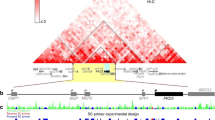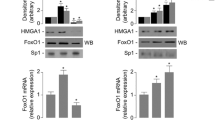Abstract
Soluble glycerol-3-phosphate dehydrogenase 1 (GPD1, EC 1.1.1.8) plays important roles in the synthesis of triacylglycerol and in the glycerol-3-phosphate shutter. Though GPD1 is expressed in most adult tissues, little is known about the regulation of its expression. In this study, we analyzed the characters, organization and core region of the promoter of pig GPD1 gene by in silico analysis and activity detection of deletion mutants. We also identified and testified the negative regulation effect of C/EBP β on pig GPD1 gene by Chromatin immunoprecipitation (ChIP) assay and over-expression experiments in cultured pig kidney cells. Compared to that of human, pig GPD1 gene promoter has three conserved regions and one deletion region. In silico analysis indicated that pig GPD1 promoter was TATA-less with at least 3 CpG islands of over 200 bp in length and over 60% in GC content. The activity detection of deletion mutants suggested that the essential elements required for the optimal promoter activity scatter in the promoter region, while the core promoter region was from -422 bp to -1 bp. Chromatin immunoprecipitation (ChIP) assay results indicated that C/EBP β had plenty of binding sites in pig GPD1 promoter with the common cis-element (5’- TKNNGCAAK -3’). The over-expression examination of C/EBP β showed that the expression of GPD1 was negatively regulated by C/EBP β in pig kidney cells. Overall, our study revealed that the pig GPD1 promoter is a TATA-less promoter, and in promoter region, the binding sites of C/EBP β share common motif of (5’-TKNNGCAAK -3’). We also showed that pig GPD1 gene is regulated negatively by C/EBP β in cultured kidney cells.



Similar content being viewed by others
References
Anish R, Hossain MB et al. (2009) Characterization of transcription from TATA-less promoters: identification of a new core promoter element XCPE2 and analysis of factor requirements. PLoS ONE 4(4):e5103
Arizmendi C, Liu S et al. (1999) The transcription factor CCAAT/enhancer-binding protein beta regulates gluconeogenesis and phosphoenolpyruvate carboxykinase (GTP) gene transcription during diabetes. J Biol Chem 274(19):13033–13040
Baek D, Davis C et al. (2007) Characterization and predictive discovery of evolutionarily conserved mammalian alternative promoters. Genome Res 17(2):145–155
Butler JEF, Kadonaga JT (2002) The RNA polymerase II core promoter: a key component in the regulation of gene expression. Genes Dev 16(20):2583–2592
Chen SS, Chen JF et al. (2000) C/EBPbeta, when expressed from the C/ebpalpha gene locus, can functionally replace C/EBPalpha in liver but not in adipose tissue. Mol Cell Biol 20(19):7292–7299
Chiu CH, Lin WD et al. (2004) Effect of a C/EBP gene replacement on mitochondrial biogenesis in fat cells. Genes Dev 18(16):1970–1975
Cortes-Canteli M, Pignatelli M et al. (2002) CCAAT/enhancer-binding protein beta plays a regulatory role in differentiation and apoptosis of neuroblastoma cells. J Biol Chem 277(7):5460–5467
Darlington GJ, Ross SE et al. (1998) The role of C/EBP genes in adipocyte differentiation. J Biol Chem 273(46):30057–30060
Davuluri RV, Suzuki Y et al. (2008) The functional consequences of alternative promoter use in mammalian genomes. Trends Genet 24(4):167–177
Fisher M (1984) Neuronal influence on glial enzyme expression: evidence from mutant mouse cerebella. Proc Natl Acad Sci USA 81(14):4414–4418
Fisher M, Mullen RJ (1988) Neuronal influence on glial enzyme expression: evidence from chimeric mouse cerebellum. Neuron 1(2):151–157
FitzGerald PC, Shlyakhtenko A et al. (2004) Clustering of DNA sequences in human promoters. Genome Res 14(8):1562–1574
Gao YZ, Jiang Y et al. (2010) "Molecular characteristics and expression profiles of glycerol-3-phosphate dehydrogenase 1 (GPD1) gene in pig." Molecular Biology Reports: 1–7
Giroix MH, Baetens D et al. (1992) Enzymic and metabolic anomalies in islets of diabetic rats: relationship to B cell mass. Endocrinology 130(5):2634–2640
Gwynn B, Lyford KA, Birkenmeier EH (1990) Sequence conservation and structural organization of the glycerol-3-phosphate dehydrogenase promoter in mice and humans. Mol Cell Biol 10(10):5244–5256
Johnston LA, Kotarski MA et al. (1989) An ubiquitously expressed gene 3.5 kilobases upstream of the glycerol-3-phosphate dehydrogenase gene in mice. Mol Cell Biol 9(3):935
Kimura K, Wakamatsu A et al. (2006) Diversification of transcriptional modulation: large-scale identification and characterization of putative alternative promoters of human genes. Genome Res 16(1):55–65
Kornberg A, Pricer WE (1953) Enzymatic esterification of α-glycerophosphate by long chain fatty acids. J Biol Chem 204(1):345–357
Kozak LP, Burkart DL et al. (1982) Unlinked structural genes for the developmentally regulated isozymes of sn-glycerol-3-phosphate dehydrogenase in mice. Dev Genet 3(1):1–6
Kozak LP, Kozak UC et al. (1991) "Abnormal brown and white fat development in transgenic mice overexpressing glycerol 3-phosphate dehydrogenase". Genes Dev 5(12A):2256–2264
Landry JR, Mager DL et al. (2003) Complex controls: the role of alternative promoters in mammalian genomes. Trends Genet 19(11):640–648
Liu S (2010) Increasing alternative promoter repertories is positively associated with differential expression and disease susceptibility. PLoS ONE 5(3):e9482
Matsuno F, Chowdhury S et al. (1996) Induction of the C/EBP beta gene by dexamethasone and glucagon in primary-cultured rat hepatocytes. J Biochem 119(3):524–532
Millward CA, Heaney JD et al. (2007) Mice with a deletion in the gene for CCAAT/enhancer-binding protein β are protected against diet-induced obesity. Diabetes 56(1):161–167
Osada S, Yamamoto H et al. (1996) DNA binding specificity of the CCAAT/enhancer-binding protein transcription factor family. J Biol Chem 271(7):3891–3896
Patsouris D, Mandard S et al. (2004) PPARα governs glycerol metabolism. J Clin Investig 114(1):94–103
Ratner PL, Fisher M et al. (1981) The role of mRNA levels and cellular localization in controlling sn-glycerol-3-phosphate dehydrogenase expression in tissues of the mouse. J Biol Chem 256(7):3576–3579
Robinson GW, Johnson PF et al. (1998) The C/EBPβ transcription factor regulates epithelial cell proliferation and differentiation in the mammary gland. Genes Dev 12(12):1907–1916
Smale ST, Kadonaga JT (2003) The RNA polymerase II core promoter. Annu Rev Biochem 72(1):449–479
Swierczynski J, Zabrocka L et al. (2003) Enhanced glycerol 3-phosphate dehydrogenase activity in adipose tissue of obese humans. Mol Cell Biochem 254(1):55–59
Thomas MC, Chiang CM (2006) The general transcription machinery and general cofactors. Crit Rev Biochem Mol Biol 41(3):105–178
Zahnow CA, Cardiff RD et al. (2001) A role for CCAAT/Enhancer binding protein {beta}-liver-enriched inhibitory protein in mammary epithelial cell proliferation. Cancer Res 61(1):261–269
Zhu Q, Halfon M (2009) Complex organizational structure of the genome revealed by genome-wide analysis of single and alternative promoters in Drosophila melanogaster. BMC Genomics 10(1):9
Zhu J, He F et al. (2008) On the nature of human housekeeping genes. Trends Genet 24(10):481–484
Author information
Authors and Affiliations
Corresponding author
Rights and permissions
About this article
Cite this article
Gao, Y., Pan, Y. CCAAT/enhancer binding protein-beta negatively regulates the expression of glycerol-3-phosphate dehydrogenase 1 in pig PK-15 cells. J Appl Genetics 52, 451–458 (2011). https://doi.org/10.1007/s13353-011-0050-4
Received:
Revised:
Accepted:
Published:
Issue Date:
DOI: https://doi.org/10.1007/s13353-011-0050-4




